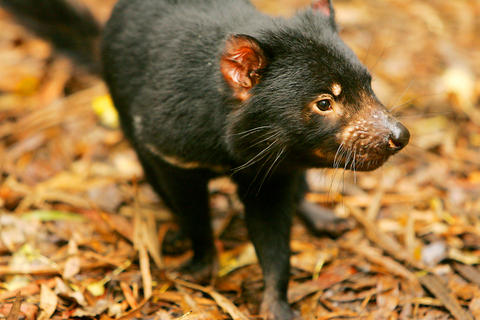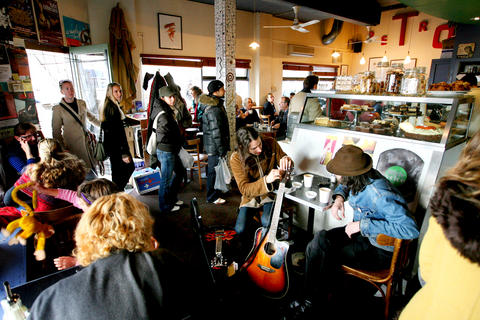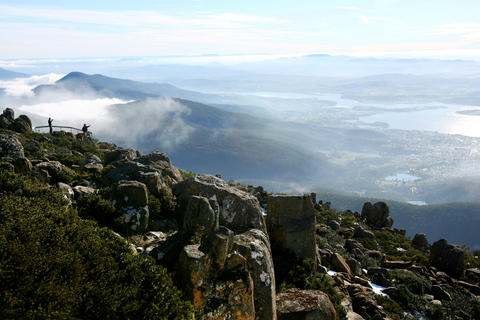It's Friday afternoon in the Tasmanian capital, Hobart, and the crowd at Retro, a harborside cafe adorned with free-form mosaic art, is decidedly offbeat. A fleece-clad couple sip lattes and a spiky-haired musician carrying a guitar case greets a friend. A cyclist in spandex pedals by so slowly that his wheels barely move.
Just above the port, strong westerly winds buffet the 1,269m-high Mount Wellington, bringing icy air from one of the world's longest uninterrupted stretches of ocean. At its peak, stunted eucalyptus trees take on spectral shapes, and the views seem to stretch toward Antarctica. But the weather in Hobart's coves, sheltered by the mountain, is balmy. At the cafe, there's mist, then a sun shower, then a rainbow, then brilliant sunshine.
Change happens slowly in Hobart, and that's the way the residents like it. Balanced on the southern edge of an island that is Australia's smallest state, 241km south of the mainland, Hobart, a city of 195,000, has been spared the scars of rapid development. Sandstone warehouses from the port's whaling days and Victorian era-gingerbread houses have been lovingly preserved. Squid boats still dock at the active piers, laced with 19th-century drawbridges. The nation's oldest continuously working pub, the Hope and Anchor, serves beer from the 175-year-old Cascade Brewery, just up the mountain.

PHOTOS: NY TIMES NEWS SERVICE AND AFP
Yet a sense of energy animates the city these days, fueled by an artistic undercurrent and celebrated natural surroundings. Hikers swing through town before setting off to explore the region's temperate rain forests and pristine seas. Foodies arrive to sample the world's largest supply of wild abalone, as well as wild duck, hare and other local game. Farmers experiment with niche-market products like artisanal goat cheese and milk-fed lamb. And vintners grow cold-climate wines in the Coal River Valley, just 20 minutes outside Hobart.
The changes are echoed in the city. Architects are updating venerable structures with steel and glass. Artists are moving in, attracted by the city's still-mellow vibe and proximity to nature. And tourism is way up, in part because major cruise lines now make Hobart a regular stop.
"I moved to Hobart after 10 years in Brooklyn because I thought Australia is the best country on earth, Tasmania the best part of Australia, and Hobart the cultural epicenter of Tasmania," said Brian Ritchie of the rock group the Violent Femmes, a recent immigrant to the city. "Within 24 hours of landing here, I did unscheduled performances and recording sessions because the musicians are not too paranoid to say, 'Let's try something.'"

Much of Hobart's new sense of style is centered along its harbor, site of Australia's second settlement in 1804. Convicts from the British Empire and gold prospectors created a rowdy, whiskey-soaked district. Today, young professionals linger at cafes and browse though Tasmanian art galleries tucked into old sandstone warehouses.
The harbor's cultural revival began with the Salamanca Arts Center, which restored seven warehouses in the mid-1970s and turned them into exhibition halls and studio spaces for contemporary artists. On a recent visit, an 2.4m-tall Mobius paper strip hung in the main gallery, part of a biannual art festival that drew plaid-skirted schoolgirls and culture seekers from mainland Australia.
The Henry Jones Art Hotel, just across the pier from the Art Center, is the other anchor of Hobart's renaissance. Opened in 2004 in the shell of a 1860s jam factory, the hotel updates the building's sandstone facades and corrugated iron roof with industrial-sleek steel and glass. In the hallways and guest rooms, works from emerging local artists - most of it for sale - hang amid glowing wood beams. Each Friday, the hotel offers a Champagne-soaked art tour, which attracts art-savvy travelers from Adelaide, Sydney, and Melbourne, along with a smattering of American and British guests.

Other high-end boutique hotels are on their way. A Tasmanian architect, Robert Morris-Nunn, who designed the Art Hotel, recently completed work on Hobart's most luxurious hotel to date, the 11-room Hotel Islington. The hotel, in a restored 1847 country manor, evokes a private hilltop home. A Picasso etching hangs in the foyer, and windows and furnishings are drenched in fine Jim Thompson silks.
It's a far cry from the country-town feel of the rustic taverns and flowery bed-and-breakfasts that still typify most Tasmanian lodging. Tasmania "is becoming a boutique island," said Nicholas Parkinson-Gates, the Hotel Islington's impeccably dressed general manager.
The dining scene is also changing. Traditional, hearty pub fare like Cornish pasties and spaghetti bolognese (in its very mild Australian incarnation) is still everywhere. But sneaking onto menus are items like scallops with truffle oil and fresh oysters drizzled with limoncello. At Restaurant 373, a new minimalist-style bistro with crisp white tablecloths, locals tuck into nouvelle dishes that blend native ingredients with international flavors, like wallaby filet with sweet potato rosti and Tasmanian pepper berries.
The sidewalks still tend to roll up early in Hobart, but a growing number of trendy bars vie for the city's budding Euro-chic crowd. Patrons at Tavern 42 Degrees South, arguably the city's hippest bar, nod to lounge music as they recline on 1970s-style blue-vinyl couches. Yet, casually dressed patrons in fleece jackets and jeans also linger at the bar, keeping the scene low-key and neighborhood-like.
The real action takes place during the day, when nature beckons. Alpine terrain and sweeping views are as close as the top of Mount Wellington, a short drive from the city center. From its peak, bicyclists can zip downhill through towering eucalyptus forests - almost no pedaling required - past the Cascade Brewery and all the way into town.
At the base of the mountain is the tranquil Silver Falls. Tall tree ferns bend over the path, and a gurgling brook rushes over mossy boulders. The air is so clean and icy, it tingles when breathed. At the foot of the path, the rustic Fern Tree Tavern serves Devonshire tea and spirits to chilled hikers, as it has for more than a century.
A 40-minute drive south of the city is Bruny Island, a place of rolling hills, curved white-sand beaches and turquoise bays. Pontoon boats take visitors off shore into the Southern Ocean where low-flying albatross swoop over schools of dolphins. Fur seals laze on rocky outcroppings. Thick strands of bull kelp, which can grow more than a foot a day, frame the stone walls of towering sea cliffs.
"It reminds me of how Australia was 20 years ago," said Greg Parnell, a retired air force pilot from Adelaide, as he stood on a pontoon boat, marveling at the spectacular scenery. "It's so natural, so beautiful."
Next to him, Colin Langhan, the boat's captain, chimed in. "Hobart's a place where you can still catch a fish, talk to fishermen on the docks, drop into a bar and meet the locals," he said. "You can't really do that in Sydney anymore."
MOUNTAINS TO CLIMB AND PLACES TO STAY
Getting there
Return flights from Taipei to Sydney start from NT$19,610, taxes excluded, with Thai Airways and Alitalia through www.eztravel.com.tw. Low-cost flights within Australia from Melbourne and Sydney to Hobart are available with JetStar and Virgin Blue, which offer one-way flights starting at US$69.
Where to Stay
Rooms at the Henry Jones Art Hotel (25 Hunter St; +61-3-6210-7700; www.thehenryjones.com) start at US$223 per night night.
The Islington Hotel (321 Davey St; 61-3-6220-2123; www.islingtonhotel.com) opened in 2006 and has three types of rooms: formal in the main house, contemporary in the garden house and standard and superior rooms in each. Doubles start at US$344.
For a blend of privacy and style, visitors can rent a restored Victorian-style home. The Kinvara House (86 Forest Road; 61-3-6278-8232; www.tasmanianindulgence.com.au) has sweeping views of the city starting at US$208 a night. For cheaper digs, doubles at the funky Edinburgh Gallery Bed and Breakfast (211 Macquarie St; 61-3-6224-9229; www.artaccom.com.au) start at US$103.
Discounts are available in the winter season (May to Sept.). Check www.wotif.com for last-minute hotel deals.
Thing to Do
The Salamanca Arts Center (77 Salamanca Place; +61-3-6234-8414; www.salarts.org.au) has contemporary art shows. Mount up for a three-hour descent of Mount Wellington with Island Cycle Tours (281 Liverpool St; +61-3-6234-4951; www.islandcycletours.com). The cost is US$56 a person.
Tasman National Park (www.parks.tas.gov.au) has lovely coastal scenery. Mount Field National Park, 80km from Hobart, has rain forests, waterfalls, alpine tundra and summer skiing. Hobart is also a jumping-off point to southwest Tasmania, a place where no roads go. Par-Avion Wilderness Tours (Cambridge Airport; +61-3-6248-5390; www.paravion.com.au) has tours starting at US$168.

As Donald Trump’s executive order in March led to the shuttering of Voice of America (VOA) — the global broadcaster whose roots date back to the fight against Nazi propaganda — he quickly attracted support from figures not used to aligning themselves with any US administration. Trump had ordered the US Agency for Global Media, the federal agency that funds VOA and other groups promoting independent journalism overseas, to be “eliminated to the maximum extent consistent with applicable law.” The decision suddenly halted programming in 49 languages to more than 425 million people. In Moscow, Margarita Simonyan, the hardline editor-in-chief of the

Six weeks before I embarked on a research mission in Kyoto, I was sitting alone at a bar counter in Melbourne. Next to me, a woman was bragging loudly to a friend: She, too, was heading to Kyoto, I quickly discerned. Except her trip was in four months. And she’d just pulled an all-nighter booking restaurant reservations. As I snooped on the conversation, I broke out in a sweat, panicking because I’d yet to secure a single table. Then I remembered: Eating well in Japan is absolutely not something to lose sleep over. It’s true that the best-known institutions book up faster

The latest Formosa poll released at the end of last month shows confidence in President William Lai (賴清德) plunged 8.1 percent, while satisfaction with the Lai administration fared worse with a drop of 8.5 percent. Those lacking confidence in Lai jumped by 6 percent and dissatisfaction in his administration spiked up 6.7 percent. Confidence in Lai is still strong at 48.6 percent, compared to 43 percent lacking confidence — but this is his worst result overall since he took office. For the first time, dissatisfaction with his administration surpassed satisfaction, 47.3 to 47.1 percent. Though statistically a tie, for most

Though the total area of Penghu isn’t that large, exploring all of it — including its numerous outlying islands — could easily take a couple of weeks. The most remote township accessible by road from Magong City (馬公市) is Siyu (西嶼鄉), and this place alone deserves at least two days to fully appreciate. Whether it’s beaches, architecture, museums, snacks, sunrises or sunsets that attract you, Siyu has something for everyone. Though only 5km from Magong by sea, no ferry service currently exists and it must be reached by a long circuitous route around the main island of Penghu, with the